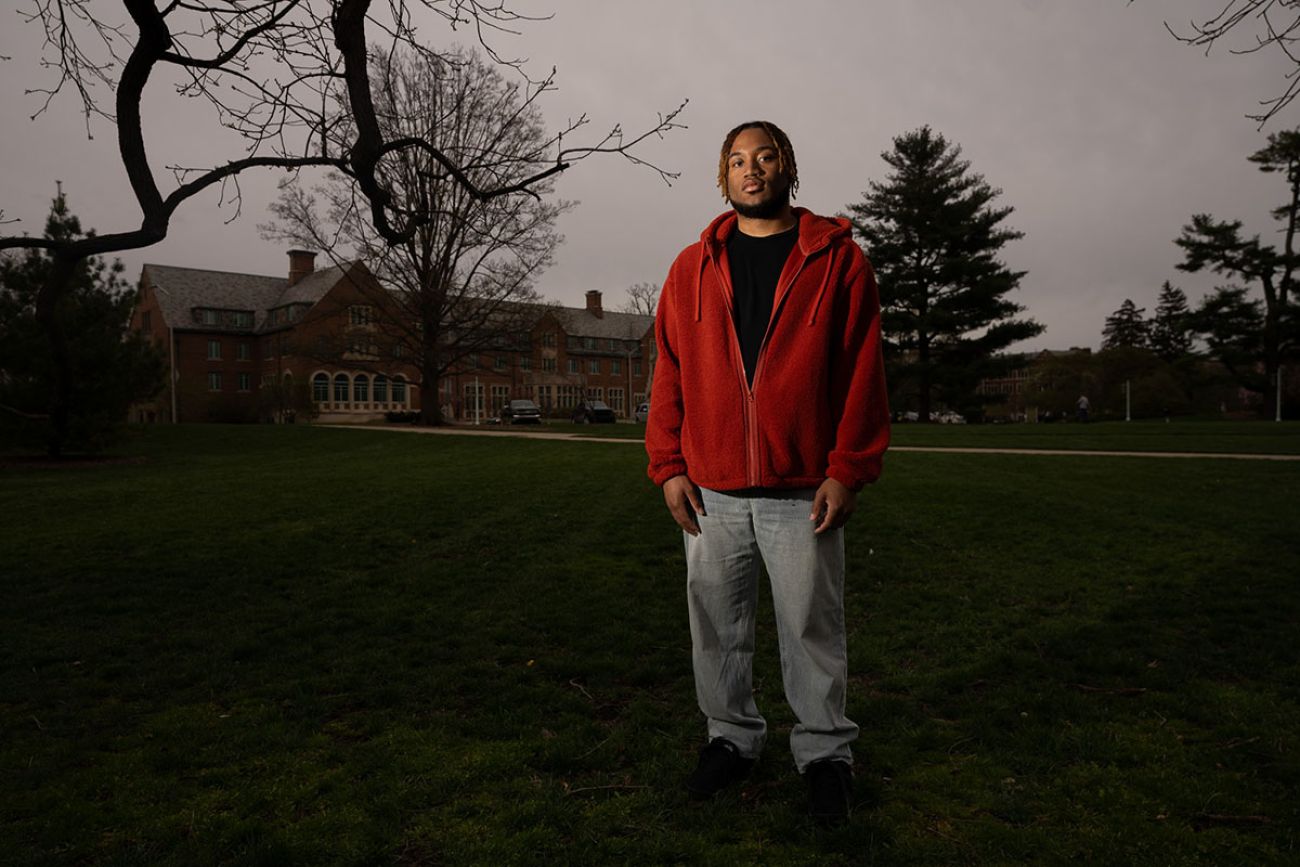For children of Flint water crisis, stigma lives on: ‘I feel like a lab rat’

- About 16,000 Flint children were age 10 or younger at the time of the water crisis in 2014-15
- Many who lived through it say they’re exhausted by the trauma and negative perceptions placed on them
- While high lead levels can lower IQs, research indicates trauma from the crisis may have inflicted more harm than lead
FLINT — For the children of Flint, the water crisis never ended.
Most still do not drink tap water, even when they travel outside the city. On average, they do worse in school, are more depressed and have a profound distrust of government.
And they are very, very tired of being stigmatized by a crisis that some are too young to remember.
For 10 years, the children of Flint have been poked and prodded to gauge the harm caused by one of the most highly publicized cases of lead poisoning in America. Now, a decade after the city fatefully switched the city’s water supply to the Flint River, there is growing doubt about the level of harm the neurotoxin caused.
What is clear: the crisis casts a long shadow over those who were young in 2014 and 2015, who now range from late elementary to college students.
“Sometimes I feel like a lab rat, when I’m no different from anyone else,” said Melodie Marsh, now a freshman at Howard University in Washington, D.C. “I’m just a kid from Flint, Michigan.”
Bridge spoke to Flint youth who grew up during the crisis, as well as parents, teachers, physicians, researchers and community activists. What emerged is a more complicated and potentially more hopeful portrait than what was feared a decade ago.
Many children are doing well in school despite community fears of brain damage, while those who are struggling place the onus on lead. Many describe a life under a microscope, while others feel ignored. All have a metastasized distrust of government
What they don’t have, according to recent analyses, is irreversible brain damage from lead.
Youths who spoke to Bridge describe the same battery of psychosocial issues present in other low-income communities of color, but with the extra burden of diminished expectations born in the water crisis.
That’s actually good news: if children aren’t doomed to lives of lead-induced lowered opportunity, then they have the chance to succeed at the same level as students elsewhere.

“I’m not going to say I don't regret the Flint water crisis,” said Marsh, “but the negative (expectations) placed on me made me think, ‘Let me prove them wrong.’
“Yes, we’re mentally trained not to drink tap water, but I can still succeed at one of the best HBCUs (Historically Black Colleges and Universities) in the nation.”
‘People decided who we were’
There were just over 16,000 children age 10 or younger in Flint when the water crisis began.
On April 25, 2014, an emergency manager appointed by Republican Gov. Rick Snyder to shore up the city’s finances switched the water supply from Great Lakes Water Authority, the Detroit water supplier that provides treated water from Lake Huron to many communities in southeast Michigan, to the Flint River.
The move was meant to save money, but it was the first of a chain of bad decisions that led to the leaching of lead into the water supply from the lead pipes that snaked underground across the city. By the time the water supply was switched back to safer, properly treated water 18 months later, lead was showing up in blood samples of a growing number of children.
Even during the height of the Flint water crisis, there were other Michigan communities whose children had higher levels of lead in their blood. But the source of that lead was paint chips, dust and dirt from generations of use of lead in products ranging from paint to gasoline and cosmetics. Flint had those issues, too.
But the water crisis was different, because it was caused by a direct failure of government to keep citizens safe, prompting efforts to bring charges against Snyder and other government officials. Two Department of Environmental Quality employees pleaded no contest to single misdemeanor charges, but charges against Snyder and other high-ranking state officials were dismissed by state courts. Michigan Attorney General Dana Nessel ended all Flint water prosecutions last October.
“There's this constant concern that we know that what's wrong with our kid is because of a water crisis.” — Dr. Mona Hanna-Attisha
And while lead levels were declining for decades in other communities, the water crisis caused the percentage of Flint children with troubling levels of the neurotoxin in their blood to double in a period of months, from 2.2% of tested children to 4.9%.
That raised alarms among doctors. Lead can cause permanent damage. Particularly vulnerable: young children, who scientists, doctors and innumerable headlines warned at the time of the Flint crisis could suffer from diminished learning ability, behavioral problems and mental health issues.

“People had already decided who we were,” said Cruz Duhart, who was 12 when the water crisis began. “They had ideas about IQ and behavior.”
The reality is more complex, said Duhart.
He doesn’t recall having tests that showed lead in his blood but does remember the brown water that flowed from his family’s shower and faucets. He had acne flare-ups soon afterward and his mother began suffering gastrointestinal problems, both symptoms he blames on either the lead in the water or the chemicals poured into the river water to make it drinkable.
Despite fears about the impact lead would have on learning, Duhart doesn’t believe the crisis held him back academically.
Still, the stigma followed him to Morehouse College in Atlanta, from where he graduated last year. “I’ve literally had people say, ‘I thought the water crisis would make you have this or that,’ like I have some kind of disease,” he said.
“The medical effects they said were going to happen did happen to some people, but not all.”
School struggles
A University of Michigan study found that elementary students who live in Flint suffered significant decreases in learning following the crisis.
According to the study, which followed children who lived in Flint at the time of the water crisis and attended charter schools or traditional districts in the area, students experienced a substantial decline in math scores, losing the equivalent of five months of learning progress
Test scores of those children, whether they remained living in the city or moved out after the crisis, dropped more than students in 10 other urban, low-income districts in the state, including Hamtramck, Oak Park and River Rouge.
“We’re not ashamed of our community, but there is an exhaustion having to defend it.” — Cruz Duhart
That same study noted that the percentage of students in special education grew 9% above the rate of increase in similar districts after the crisis.
Another study conducted after the water crisis found that 1 in 5 of the city’s children have been diagnosed with anxiety or depression, compared to 13% of kids nationally.
That may not be because of lead. Children in poor neighborhoods tend to have higher rates of depression. One study found 22% of children living below the federal poverty line suffered from a mental, behavioral or developmental disorder.
Distrust and fear
While the water has met EPA standards for years and is tested daily, residents who spoke to Bridge say they don’t trust it.
Trust in government plummeted during the water crisis, when officials repeatedly told the public that the water was safe and downplayed findings from researchers of lead in the water.
“We had this distrust, this general dissatisfaction that the people who are supposed to be protecting us as a community kind of just took advantage of us,” said Duhart.

“And there's the deeper issue of race,” he said. “It wouldn't take advocating for a year about our water not being properly filtered in a lot of other places. So yeah, it just became this feeling of who can we trust, really?”
Dr. Mona Hanna-Attisha, a Flint pediatrician and Michigan State University School of Human Health faculty member who helped expose the crisis, said the children of Flint had overwhelming challenges even before lead seeped into the water system.
“A kid in Flint had a 15-year life expectancy difference (from other children in Genesee County) based on the ZIP code that they're born into,” Hanna-Attisha said. “There is overwhelming poverty, unemployment, disinvestment, systemic racism. And then to learn that a poison, which has no safe level, to find out my kids have been drinking this at their most developmentally vulnerable stage in their life, infancy and early childhood, everybody lost trust and faith in institutions.”
The parents she sees at Hurley Children’s Hospital in Flint are filled with “trauma, worry, guilt and fear” about what the future holds for their children.
Their biggest worry: lead.
“There's this constant concern that we know that what's wrong with our kid is because of a water crisis, and it's also a worry about their tomorrows, because I think we've been able to share that it’s a long-term problem,” she said.

Labeled unfairly
It’s been impossible even for researchers to sleuth out how much of the struggles of Flint’s children is because of lead, versus the trauma of going through a nationally televised crisis, versus the challenges of living in one of America’s poorest cities, where 1 in 3 residents live below the federal poverty line.
There’s one corrosive burden however that separates Flint from Michigan’s other poor, urban communities: the “narrative” that students couldn’t learn because of lead poisoning, said Kent Key, director of the Office of Community Scholars and Partnerships for MSU and founder of the Flint Public Health Youth Academy.

Key works with middle and high school students to encourage them to pursue health careers. He is frustrated by the narrative about Flint children.
“What was said about the kids was that they were not going to be smart enough to go to college, and they were going to have these lower IQs,” Key said. “It labeled Flint youth locally, nationally and globally. It also had and has the potential of creating a reinforcement loop where Flint youth believe that narrative and internalize it.”
‘Just like everyone else’
Everett Graham finished his freshman year at MSU in April.
In his dorm room in East Lansing, he drinks only bottled water, as he’s done since he was 9 at his home in Flint. “Just rinsing my toothbrush (with tap water), I flinch a little bit,” he said. “It's just a strange thing to even have to think about that: ‘Hey, maybe like this water isn't good for me.’”
“That's not an exaggeration,” said Graham, who doesn’t recall if he ever had a test indicating lead in his blood. “That's real trauma. It actually changed me. And it wasn't fair.”
Graham’s experiences in 2014 and 2015 were similar to thousands of other Flint children — going from drinking water from the tap one day to figuring out how to bathe with bottled water the next.
“When people hear that you're from Flint, it's one of the first things that they want to hear, ‘What was that experience like?’” Graham said. “And there's even trauma behind that. I went from very confused, very angry. I really don't even know how to explain my experience.”
“I get all the medical and science behind why (people viewed Flint children as lead-poisoned),” he said. “But the stigma that was placed on us was unfair.”
Marsh, the freshman at Howard University, calls the mental and emotional weight of being from Flint “exhausting.”
That’s a word recent Morehouse graduate Duhart also uses about having to battle the narrative that “you’re not going to amount to much.”
“We’re not ashamed of our community,” Duhart said, “but there is an exhaustion having to defend it.”
“We are people just like everyone else,” said MSU freshman Graham. “And yeah, those statistics are things that you read, and there definitely have been people who have been harmed, but that’s not the full picture.
“If you actually want to know, you're not going to find our story in a medical journal, you have to just come speak to us.”
See what new members are saying about why they donated to Bridge Michigan:
- “In order for this information to be accurate and unbiased it must be underwritten by its readers, not by special interests.” - Larry S.
- “Not many other media sources report on the topics Bridge does.” - Susan B.
- “Your journalism is outstanding and rare these days.” - Mark S.
If you want to ensure the future of nonpartisan, nonprofit Michigan journalism, please become a member today. You, too, will be asked why you donated and maybe we'll feature your quote next time!








